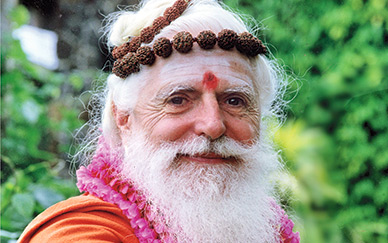More Photos from Jayendrapuriswami’s Recent Visit
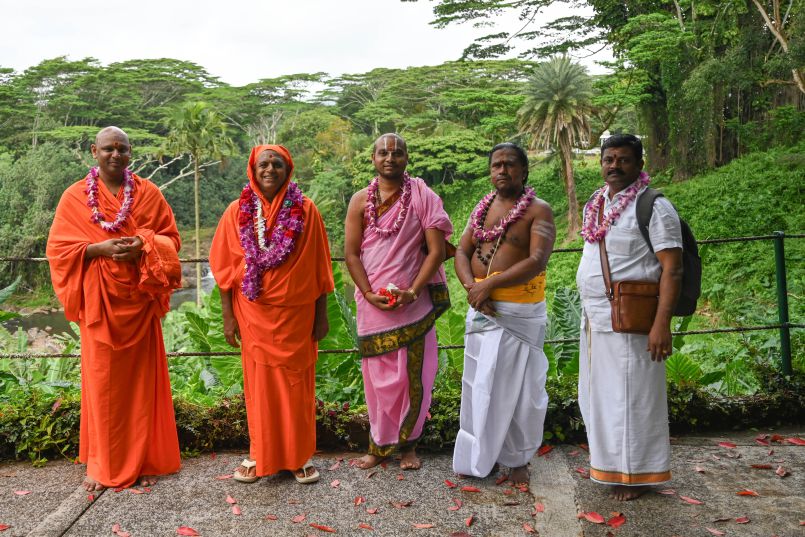
Aum Namah Sivaya
On Swami's recent visit to the aadheenam, he and his entourage had time to explore the many areas around the property, including our temples, the Wailua River, the publication's offices, the gardens, the rudraksha forest and more. Swami was also able to attend Vaikasi Visakam while here as well as have lunch with the monks.
Botanical Event Today!

For the first time, our Amorphophallus kojak has blossomed at the monastery. It's called the "Corpse Flower" since it smells like a dead rat, a trick the plant plays to attract flies to pollinate it. The larger species, titanum, only blossoms once in a decade or so, and when it does, it ends up on the front page of the local papers, inviting plant lovers to come to the garden and experience something truly unique. Enjoy the slideshow.
So compelling is the experience, someone wrote this poem about it.
Ode to the Corpse Flower
O grand Amorphophallus titanum, you rise,
A behemoth in disguise,
Unfurling without a care,
Filling the greenhouse air.
They flock to see your rare display,
Braving your bouquet of decay,
A scent of socks left out in the rain,
Mixed with fishwhat a strange refrain!
Your petals stretch, a burgundy throne,
But oh! The smells you own,
Like a banquet left to spoil
A testament to your arduous toil.
For every decade, maybe one grand show,
To which admirers gladly go,
Despite the olfactory plight,
To witness your blooming might.
Titan Arum, they call you too,
A titan, indeed, with a whiff of the zoo!
Yet in this odd floral fest,
Your stinky best is still the best.
Laugh, dear reader, hold your nose,
And marvel at how nature composes,
Such curious forms and scents,
In this peculiar floral event!
The Purpose of Life, Part Four
Satguru Bodhinatha Veylanswami gives his weekly upadesha in Kadavul Temple at Kauai’s Hindu Monastery in Hawaii. It is part of a series of talks elaborating on the inspired teachings of Satguru Śivaya Subramuniyaswami as found in his book Merging With Śiva.
"Basic principles for a good foundation in our lives can be established through consistency. The consistency in approach to what we are doing—a good habit pattern in living our life, as we approach our inner life, the understanding of our inner life, the study of it and the experience of it—has to be on a day-to-day basis. Developing a contemplative lifestyle that is sensible, that is positively worked out, and programming that into our complete pattern of daily life gives us a foundation strong enough to face decisions and the ensuing experiences and the reaction to those experiences in a way that they enhance our spiritual unfoldment. Remember, the lifestyle that we now have was programmed for us by mothers, fathers, religious leaders, teachers, people that we had just met along the way, and good friends. It’s not a particularly good lifestyle in which to hold the perspective that we’re an immortal being. It’s a great lifestyle to hold the perspective that we’re a temporal being, and we’re only here a few years and then we die.”
More Photos from Jayendrapuriswami’s Visit
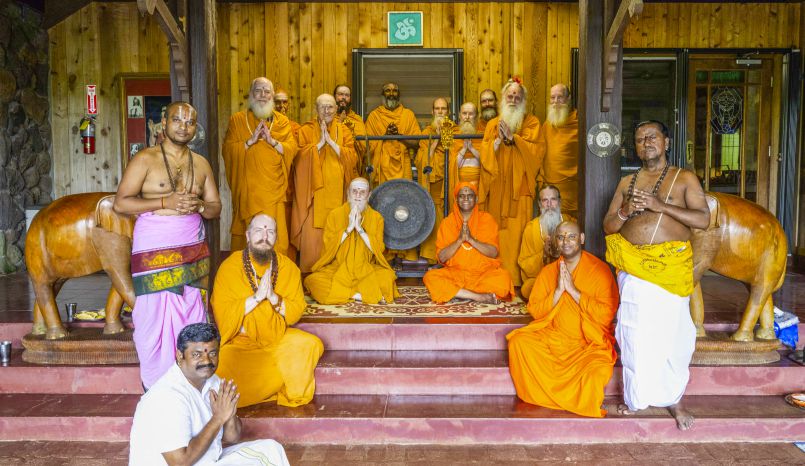
Aum Namah Shivaya
During Swami's 2024 visit to the Aadheenam, he had the chance to meet with the monks and explore different areas and projects being worked on. During one morning, he toured Iraivan Temple with Yoginathaswami, followed by the visiting the Siddhidatta Kulam new shop, offices and the green houses.
Rajen Manick Reminisces Kauai Aadheenam Grounds, Part Two
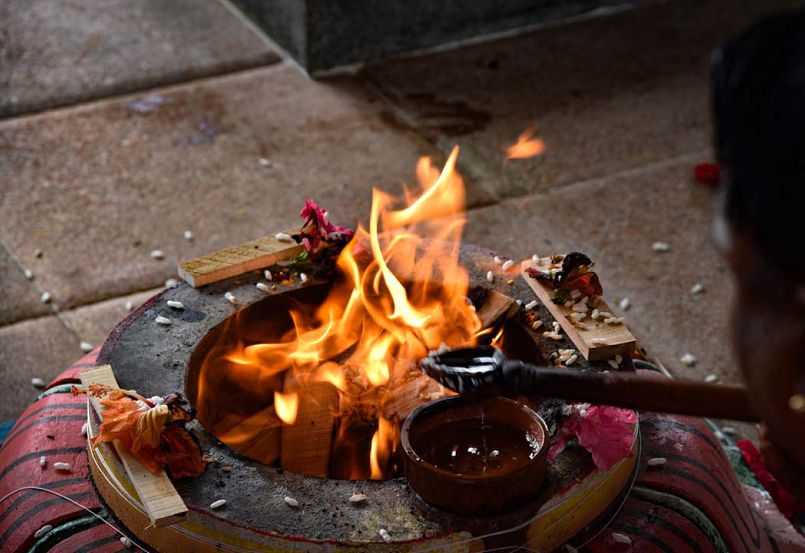

Here is the other half of miscellanous scenes that SSC sishya Rajen Manick captured during his taskforce period before returning home to Mauritius. He had a darshan meeting with Satguru just before departing to discuss personal life and mission matters in Mauritius. The rest of the photos are mostly from Iraivan Temple's first yearly anniversary pujas.
Ganapati Kulam Morning Meeting
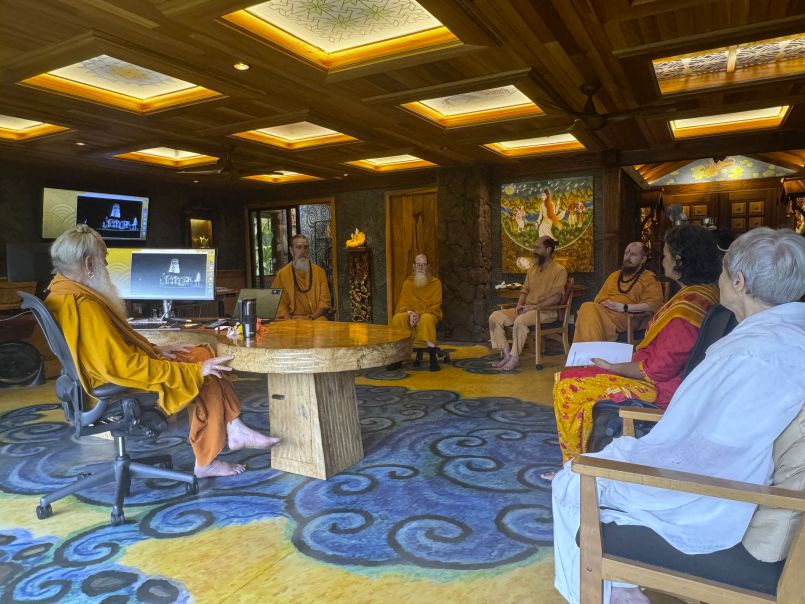
Om Namah Shivaya
As we know, the monastery's monastics all serve in varied kulams during their hours of daily seva. Beginning at 8am on each day of their week, the Ganapati Kulam has a meeting to plan their day and discuss their many projects. This is the kulam that is responsible for both print and digital publishing, including Hinduism Today magazine and our books, websites, apps, etc. Many of them also help with pujas, cooking, care for our agricultural lands, and a variety of other projects. Today's meeting included some special guests. We had Vasanthakumari, who is here from Malaysia and Valli Anand who lives on the island. Both do exemplary seva here at the temple each day. Rajkumar (who took these photos) also attended. Aum.
Amazing Timing
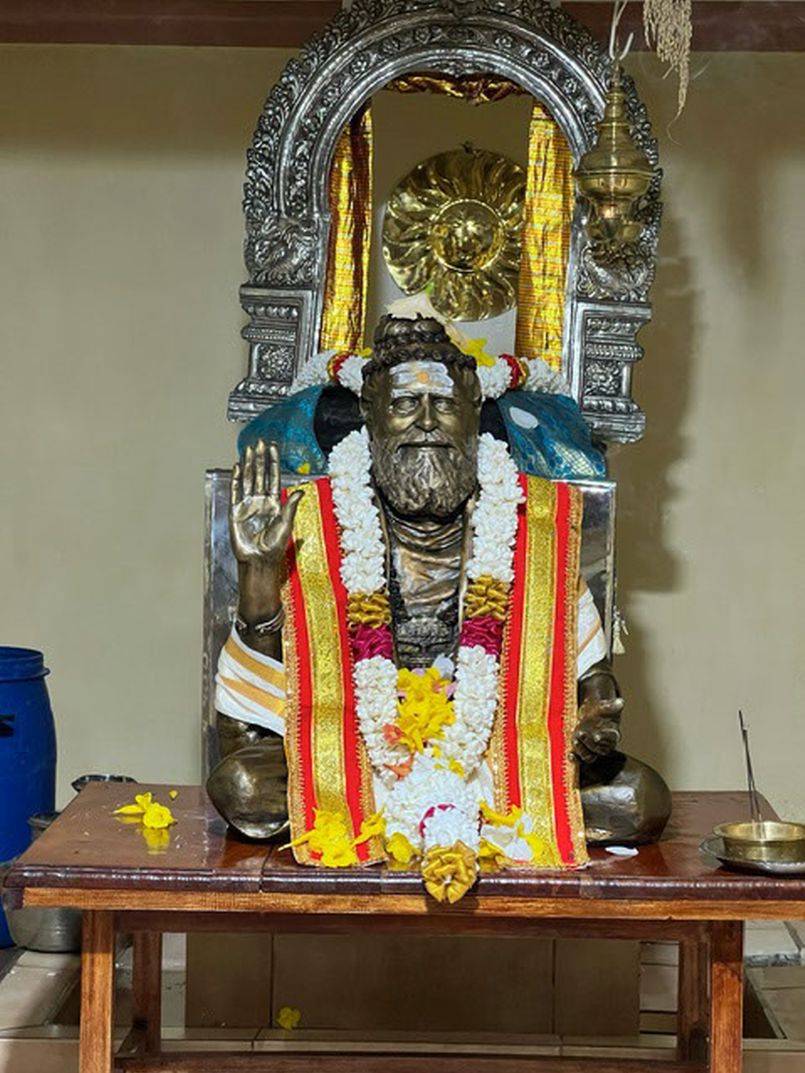
It could not have been planned in this day of uncertain shipping schedules. The remarkable bronze murti of Gurudeva left Colorado and flew to Colombo, Sri Lanka, arriving in time for Thondunatha to guide it through customs and drive 6-7 hours north to Jaffna just time time for the 75th anniversary of Gurudeva's initiation by Yogaswami on the full moon day in May, 1949. Devotees were in awe of the propitious timing. The murti was taken first to Nallur Temple for darshan of Lord Murugan, then to Yogaswami's Ashrama in Columbothurai for a reception and abhishekam. Read Thondunatha's note to Satguru Bodhinatha Veylanswami for the story from Jaffna.
Dear Bodhinatha,
On Tuesday, Vaikasi Visakam, Gurudeva arrived in Jaffna. That evening, we escorted Gurudeva to the Nallur Temple, and subsequently to Columbuthurai Yogaswamis ashram to commemorate the 75th anniversary of Gurudeva's initiation by Yogaswami on the full moon day in May 1949.
The priest performed a wonderful abishekam to both Yogaswami's Thiruvadi and Gurudeva. Everyone present felt the strong spiritual presence of both Yogaswami and Gurudeva. Holly Young did an exceptional job creating the statue. Thank you so much, Paramacharya, for coordinating the creation of Gurudevas statue for Alaveddy.
Gurudeva is now resting in Alaveddy, awaiting the arrival of the other gurus. It truly feels as if Gurudeva has returned to Jaffna.
Love,
Thondunathan
The Purpose of Life, Part Three
Satguru Bodhinatha Veylanswami gives his weekly upadesha in Kadavul Temple at Kauai’s Hindu Monastery in Hawaii. It is part of a series of talks elaborating on the inspired teachings of Satguru Śivaya Subramuniyaswami as found in his book Merging With Śiva.
"Meditate on man being like a lotus flower. He comes through the mud, his instinctive mind, and he’s aware of the things of the instinctive mind: hate and greed and love and passion, and jealousy and sorrow, and happiness and joy and excitement. He comes into the intellectual mind. He becomes aware of ancient history and predictions about the future, politics, all sorts of systems, all sorts of organizations, institutions and opinions of other people. And this consumes and overshadows the soul, life after life after life, just as the desires and cravings of the instinctive mind overshadow the soul life after life after life after life. But all this time, the body of the soul is growing up. It’s getting stronger. It’s absorbing the reactions of each lifetime, drawing more energies from the central source of energy to build up and absorb these reactions; and this is food for the soul. Then finally awareness comes into its bud state. It says, “Here I am, a bud, and I’m out of the mud, and I’m out of the water.”
Welcoming Sannyasin Mayilnathaswami!
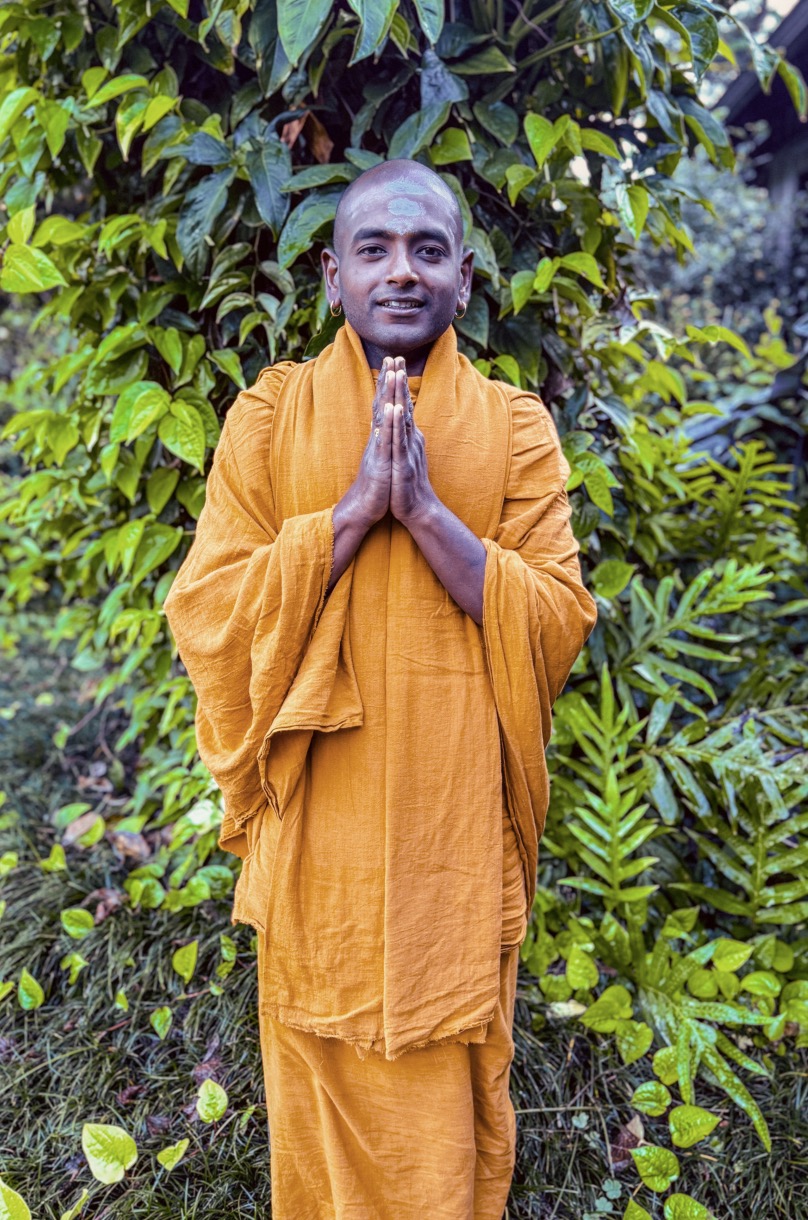
Today is the holy celebration of Vaikasi Visakam, honoring the birth of Lord Murugan. On this day the Saiva Siddhanta Yoga Order welcomed its newest swami in traditional ritual.
Thus was born Sannyasin Mayilnathaswami!
In the early morning, as the full moon set over Mount Waialeale, our newest swami, along with Satguru and all the swamis of the order, symbolically conduct Swami's antyesti samskara. These are the traditional funeral rites, which here, betoken the death of the personal self and the birth of the spiritual being. He places the remnants of personal identity, clothing, pulnool or sacred thread and all desires for wealth, progeny and fame into the homa fire, beseeching the permission of Lord Ganesha and heeding the path of Lord Muruga, vowing aloud his renunciation thus: "All that I have and all that I am I now give unto my God, my Gods and my guru. I have no family except the Divine Father Siva and Mother Sakti who dwell in Kailas and on Earth the sangam of Saivite devotees. I have no home except the stillness of Being. I have no possessions except my faith and dedication. I have no desires except my desire to serve and to realize God." The candidate then says aloud three times, "I, wishing for mukti, take refuge in this sacred Order and in God Siva, who created the world, who breathed out the Vedas. The purpose of my life is to cultivate dispassion, to become pure, to attain union with God Siva and be immersed in Divine Love. I do fully and of my own volition accept these Holy Orders of Sannyas, now and for the remainder of my life, and bind myself in the fulfillment thereof to the ancient Order of sannyas, to my satguru, to my Saivite Hindu faith and to the devas, the Mahadevas and Lord Siva Himself. I am the Atman, the non-dual Parasiva, pure and free."
So saying, the renunciate walks around the homa fire, returning to kneel at the guru's feet. He is thereafter dead to the world. The satguru then whispers the Panchakshara Mantra in the candidate's right ear three times, along with personal instructions for meditation.
Yogaswami's words from his Natchintanai:
Hail, O sannyasin, love's embodiment!
Does any power exist apart from love?
Diffuse thyself throughout the happy world.
Let painful maya cease and ne'er return!
Day and night give praise unto the Lord.
Pour forth a stream of songs
To melt the very stones.
Attain the sight where night is not nor day.
See Siva everywhere, and rest in bliss.
Live without interest in worldly gain.
Here, as thou hast ever been, remain.
Then never will cruel sorrow venture nigh.
THE SACRED VOW OF RENUNCIATION: KNOWN IN TAMIL ASAHATTURAVU.
RENUNCIATION IS THE RELINQUISHMENT of world, desire and ego. It is detachment founded in knowledge of the magnetic nature of body, mind and emotion, a knowledge which inclines the soul toward non-involvement with external forms and, in time, summons forth realization of Parasiva, Absolute Reality. Renunciation is repudiation of individual personality and ownership. It is poverty as opposed to affluence, simplicity as opposed to ramification in life. It is self-containment, freedom from worldliness and its concomitant distractions and obligations. In its deeper sense, renunciation is a surrendering of limited identity, ego-sense or individuality known in Sanskrit asahamkara, that the soul may soar to the very depths of Being. It is the beginning of the end of samsara, the wheel of rebirths, the death of the old ushering in a spiritual renascence which will ultimately mature into illumination andmoksha. It is the ultimate ripeness of the soul and mystic marriage to God Siva. It is the Maha Vrata or Great Oath of the Saivite pathfinders and contains within it commitment to the unwritten and even unspoken customs followed by those who have worn thekavifor untold centuries.
In Tamil renunciation for the sannyasin is known asahatturavu, which means "detachment through giving up the sense of I' and mine,'" epitomizing the ideal of this Sacred Vow. Renunciation is not a running away from the world provoked by fear or failure therein. Rather it is an irrepressible drawing into sacred realms of consciousness and being far more subtle and demanding of discipline than anything the world may offer--a state of being that follows fulfillment in the world as the next natural evolution of consciousness. Renunciation is not an opportunity to shun responsibility or to do as one pleases, but carries with it challenges and accountability of an even more formidable, albeit inner, nature. It is not a disgust for this world, but a love of deeper worlds so great that the material universe and its gifts are, by comparison, mean and meager. Though he strives to be affectionately detached, the sannyasin should never become indifferent or so accepting of all that happens that he accepts passively harm to himself, his Order or his religion. The renunciate's life is not one of inactivity, but vital activity directed toward selfless and spiritual ends--an inner consciousness described in scriptures as the giving up not of work but the fruits thereof, whether apparently good or bad. It is not by virtuous acts that the sannyasin attains liberation. They are chains, though wrought in gold. No deed, however altruistic, is without its bearing on the ego of the doer; and thus the sannyasin holds firmly to his detachment even in the midst of his bountiful benevolence.
Renunciation is the abjuration of the grihastha dharma and the acceptance of the sannyasa dharma, a dharma which will create or resolve karmas according to how it is discharged. Though it disallows personal possessions and upholds the ideals of simplicity known as poverty, renunciation is not a condition of destitution, deprivation or disregard for one's well-being. Nor is it a resignation from life or an abandoning of humanity, but a fulfilling of mankind's highest need and a joyous surrender to That which is the substratum of life. It serves not man, but God in man, not the body but the spirit within the body. Renunciation for the sannyasin may be defined as wisdom in handling of karma, maya and desire. He must strive to free the mind from the thralldom of the senses. He must work diligently to extirpate vanity and selfishness, realizing that the ego, though subdued by the strength of tapas well performed, is never annihilated as long as the soul remains embodied, but is subdued, reserving the potential to rise again should he abandon his sannyas dharma. He must strive, especially at the outset, to quell the forces of pride, pretention and conceit, never allowing himself to feel the flush of self-importance or arrogance. He must guard his modesty as a treasure, never holding himself superior to others, for there is no conceit so tenacious as the spiritual ego. Before he is well-grounded and stable in his realization, he must give up all siddhis that may arise as a natural consequence of his sadhana and unfoldment, neither desiring nor encouraging such powers. He must see the perfection resident within the souls of all men, but remain aware of his own faults and transgressions, however insignificant. He must remain equally indifferent to both praise and blame, never allowing others to extol his virtues, never speaking personally of himself or his past, even when asked. He must never accept personal gifts, however small or well intended. However, he may accept food and minimal travel assistance and receive non-personal contributions on behalf of the monastery, placing them immediately upon the altar, offered to the Lord.
The sannyasin cultivates renunciation through meditation on the transcendent Parasiva and worship of the immanent Lord Hara who removes the fetters which bind the soul. He cultivates renunciation through remaining secure within his inner consciousness and radiating the joy and contentment which are the harbingers of awakening. He cultivates renunciation through living simply, holding the consciousness that Lord Siva has entrusted to him the care of tools and personal items which he uses; such an attitude of custodianship averts any sense of possessiveness. He cultivates renunciation through patiently enduring hardship. He cultivates renunciation through performance of tapas and austerities which keep his will strong and his ego subdued. He abjures personal wants that may arise rather than seeking to fulfill them and casts off all preferences, both likes and dislikes. He accepts in trustful love all that comes, offering no complaint when ostensible needs are not provided. He practices detachment and dispassion, vairagya, consciously remaining calm, kind and quietly strong in the midst of even adverse circumstances. He cultivates renunciation by continued penetration into contemplative states of mind, withdrawing from the vortex of external consciousness into Parasiva, the Self God. He cultivates renunciation by surrendering to the will of Siva in his life, abiding in the knowledge of Sarvam Sivamayam, all is Siva, a mystic insight which will dissolve all concepts of separateness from God and offer in its stead cognition that jiva is indeed Siva. He cultivates renunciation through living on the eve of his departure, always ready to change, to move, to travel wherever he may be needed. He cultivates renunciation through not identifying with name and form, through not attaching importance to title or position. He cultivates renunciation through detachment which evolves from viveka which is discrimination to vairagya which is dispassion to tyaga which is renunciation and finally into kaivalya which is emancipation, blissful independence and moksha. He cultivates renunciation through giving up all fears of death and even desires of anticipated enjoyments of the heavenly realms. He cultivates renunciation through viewing himself as the homeless one, free and unattached, finding security within the recesses of his own being, not participating in the mundane concerns and conversations of the world, nor engaging himself in social life outside of the brotherhood of sannyasins. He cultivates renunciation through non-involvement with his family or former friends. He cultivates renunciation through remembering that this body is destined to perish, that this personality is fleeting, and identifying therefore with nothing ephemeral, but with the only permanence there is--That within which lies beyond time, form and cause. He cultivates renunciation through spurning the life that is death and embracing the death that is life eternal, transcending himself by himself.
In fulfillment of his Sacred Vow of Renunciation, the sannyasin is directed to not involve himself in matters of the world. Should worldly situations arise, whether from within the monastery or without, he is enjoined to remain silent and aloof. Neither shrinking from disturbed conditions nor feeding them by his thought and concern, he must remain ever the witness lest he hasten the harvest of such unseemly karmas. He is enjoined to keep his own personal needs moderate while not requiring the same of others and to hold firmly to his yoga and his equanimity. If he can remain the silent watcher, if he can control the wanderings of the mind sufficiently to be summa, to just be, if he can remain joyous and serene in all circumstances, if he can progressively surrender the sense of "I am the doer" and awaken the perception that "Siva does all," if he can patiently endure all hardship and maintain his tavam, standing apart from the entanglements of sex, money, food and clothes, if he can live in simplicity owning nothing in this world, not even the robes he wears, if he can never, never forget his guru and the goals of service and realization, he will have fulfilled the spirit of this Sacred Vow. May the sannyasin ever call to mind the words of the Tirukural, "Attach yourself to Him who is free from all attachments. Bind yourself to that bond in order that all other bonds may be broken."
Kauai Aadheenam 2024 Vaikasi Visakam Puja – Live Stream
Join us at 3:00pm today, Kauai time, for Kauai Aadheenam’s 2024 observance of Vaikasi Visakam, honoring Lord Murugan, God of Kundalini Yoga. This year's puja is conducted by Sri Arul Nandi Sivam, Chief Priest of Sri Rajarajeshwari Temple at Kailas Ashram. Sri Arul Nandi Sivam is visiting the Aadheenam with Sri La Sri Jayendrapuri Mahaswamiji. Aum.
From Our Gurus' Teachings
Archives are now available through 2001. Light colored days have no posts. 1998-2001 coming later.

